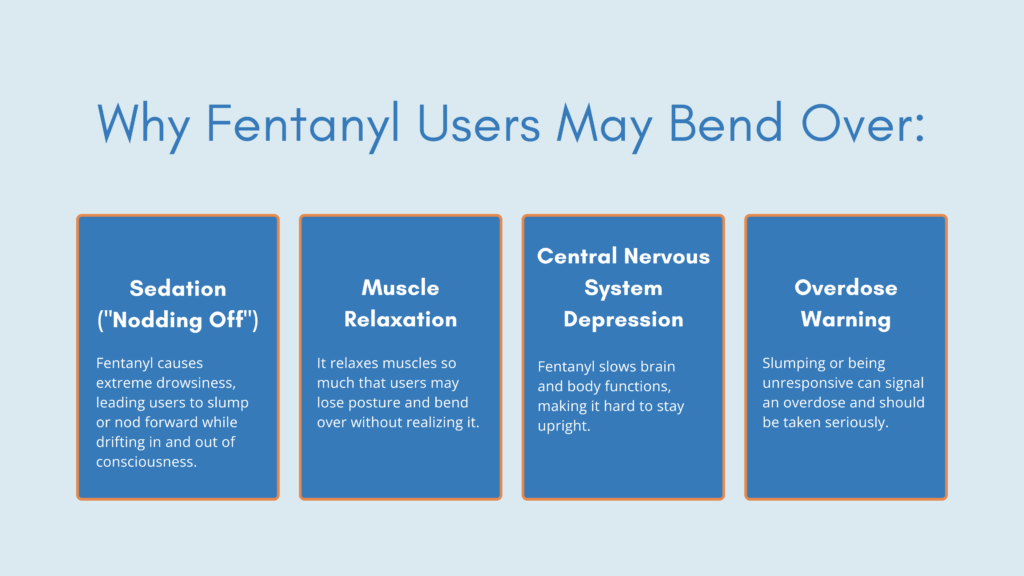Fentanyl is a powerful synthetic opioid that is up to 100 times more potent than morphine and 50 times more potent than heroin, making it extremely dangerous. As its abuse increases, a peculiar and disturbing behavior has been observed among users: bending over or hunching. This phenomenon, often referred to as the “fentanyl fold,” occurs because the drug’s potent effects on the central nervous system cause intense muscle relaxation and loss of motor control. Users lose the ability to maintain proper posture, resulting in the characteristic bending over. When comparing fentanyl vs. dilaudid, it becomes clear that fentanyl’s extreme potency presents greater risks, despite both drugs being powerful opioids.
Moreover, fentanyl’s severe impact on respiratory function contributes to this behavior. The drug can cause significant respiratory depression, leading to dizziness and lightheadedness. In an attempt to stabilize themselves and improve breathing, users might bend over involuntarily. Nearly 108,000 persons in the U.S. died from drug-involved overdose in 2022, underscoring the critical need for awareness and effective treatment interventions.
The Potency of Fentanyl
Fentanyl’s extreme potency means that even a small amount can cause severe, sometimes fatal reactions. This synthetic opioid works by binding to opioid receptors in the brain, which regulate pain and emotions. This binding action creates a sense of euphoria and profound relaxation, but it also significantly depresses the central nervous system. According to the Texas Health and Human Services, just 2 milligrams can be enough to cause an overdose in some individuals.
The central nervous system depression caused by fentanyl can lead to various physical manifestations, including the characteristic bending over observed in many users. This is due to the drug’s impact on motor control and muscle tone, causing intense relaxation and loss of coordination. The high risk of overdose and severe physical effects underscore the dangers of fentanyl use and the critical need for effective intervention and treatment. Fentanyl is often mixed with other drugs, sometimes without the user’s knowledge. For instance, there have been reports of purple fentanyl, a form of the drug mixed with various substances that create a distinctive color. This contamination increases overdose risk because users may be unaware of what they are consuming, including potent substances like carfentanil. Understanding what is carfentanil—a substance even more powerful than fentanyl—helps illustrate the lethal danger of opioids.
With fentanyl being found in unexpected places, many people worry, what if you touch something that has fentanyl on it? While casual skin contact is unlikely to cause an overdose, fentanyl exposure through inhalation or mucous membranes poses serious risks. Knowing how to handle suspected fentanyl contamination and seeking medical help when needed is crucial to preventing harm.

Why Do Fentanyl Users Bend Over?
Neurological Impact
Fentanyl’s effect on the central nervous system leads to intense relaxation and muscle weakness, causing users to lose control over their body posture. This loss of control is particularly evident in the back and neck muscles, resulting in the user bending forward or hunching over. This posture is often involuntary and indicative of the drug’s profound impact on the brain’s motor functions.
Respiratory Depression
One of the most dangerous effects of fentanyl is respiratory depression. The drug significantly slows down breathing, sometimes to a life-threatening level. Reduced oxygen intake can make users feel dizzy and lightheaded, causing them to bend over as a subconscious attempt to stabilize themselves and breathe more easily.
“Nodding Off”
Another common effect of opioids like fentanyl is “nodding off.” This state is a semi-conscious condition where the user drifts in and out of consciousness. When a person nods off, they might lean forward, bend over, or slump as they lose the ability to maintain a proper posture. This behavior is hazardous as it can lead to falls and other injuries.
Muscle Relaxation
Fentanyl induces extreme muscle relaxation, making it difficult for users to hold themselves upright. This relaxation affects the central nervous system’s signals that control muscle tone. As a result, users may bend over or slump as their muscles lose strength and tone.
The Risks of Fentanyl Abuse
Overdose
Given its high potency, fentanyl carries a significant risk of overdose. An overdose can occur quickly, especially if the drug is mixed with other substances. Overdose symptoms include extreme drowsiness, limp body, slow or stopped breathing, and loss of consciousness. Immediate medical attention is crucial in such cases to prevent fatal outcomes.
Contamination
Fentanyl is often mixed with other drugs, sometimes without the user’s knowledge. For instance, there have been reports of purple fentanyl, a form of the drug mixed with other substances that give it a distinctive color. This contamination increases the risk of overdose and other adverse effects because users may not be aware of the potency or the presence of fentanyl in what they consume.
A concerning trend is the presence of fentanyl in weed. Some users unknowingly consume marijuana laced with fentanyl, leading to unexpected and dangerous effects. This contamination can cause severe reactions, including the bending over posture, as the powerful opioid takes effect. Users who are not accustomed to opioids may experience intense and dangerous side effects, even with small amounts.
Fentanyl Statistics
- In 2020, over 5,500 people in California lost their lives to opioid overdoses, with nearly 4,000 of those deaths linked to fentanyl.
- From 2019 to 2021, California saw a 121% surge in opioid-related fatalities, reflecting a growing crisis.
- Drug trafficking organizations often traffic fentanyl in kilogram quantities, with just one kilogram having the capacity to cause 500,000 fatal overdoses.
- Fatalities from synthetic opioids, primarily illicit fentanyl, increased by over 55% and remain the leading cause of rising drug-related deaths.
- In 2024, U.S. Customs and Border Protection seized a total of 573,000 pounds of drugs, highlighting the ongoing efforts to combat drug trafficking.
How Long Does Fentanyl Stay in Your System?
Understanding the duration fentanyl stays in the system is crucial for both medical treatment and addiction recovery. Fentanyl has a relatively short half-life, but its effects can be prolonged due to its potency.
- Blood: Fentanyl can be detected in the blood for up to 12 hours after use.
- Urine: It can be found in urine for up to 3 days.
- Hair: Fentanyl can be detected in hair follicles for up to 3 months.
The exact duration can vary based on factors such as the user’s metabolism, the amount used, and the frequency of use. Knowing how long fentanyl stays in the system can help in managing withdrawal symptoms and planning for detoxification.
Addressing Fentanyl Addiction
Detoxification
Detoxification is the first step in treating fentanyl addiction. This process involves clearing the drug from the user’s body. Due to the severity of fentanyl withdrawal symptoms, detox should be conducted under medical supervision. Symptoms can include intense cravings, anxiety, muscle pain, insomnia, and gastrointestinal issues.
Residential Treatment
After detox, residential treatment provides a structured environment for recovery. Align Recovery Centers offer comprehensive residential programs designed to support individuals through the early stages of recovery. These programs include medical care, counseling, and support groups to help individuals build a foundation for long-term sobriety.
Therapy and Counseling
Therapy and counseling are critical components of fentanyl addiction treatment. Cognitive-behavioral therapy (CBT) and other evidence-based therapies help individuals understand the root causes of their addiction, develop coping strategies, and address any co-occurring mental health issues.
Support Groups
Support groups provide a community of individuals who understand the challenges of addiction. Groups like Narcotics Anonymous (NA) offer a safe space to share experiences and receive support. Participation in support groups can significantly enhance the recovery process.
Prevention and Education
Preventing fentanyl abuse starts with education. It is essential to raise awareness about the dangers of fentanyl, including its potency and the risk of contamination in other drugs. Educational initiatives should target both users and the general public to reduce the stigma associated with addiction and encourage individuals to seek help.
Fentanyl Addiction Treatment at Align Recovery Centers
The phenomenon of fentanyl users bending over is a visible manifestation of the drug’s powerful effects on the body. Understanding why this occurs sheds light on the severe impact of fentanyl on the central nervous system and highlights the urgent need for effective treatment and prevention strategies. Align Recovery Centers are dedicated to providing comprehensive care for individuals grappling with fentanyl addiction, offering hope and a path to recovery. If you or a loved one is struggling with fentanyl addiction, reach out to us for help and support.
For more information on our programs and services, please visit our website or contact us directly. Together, we can overcome the challenges of addiction and build a healthier, drug-free future.

Dana, with over 20 years in addiction therapy and counseling, is the Executive Director at Align Recovery Centers. Holding a B.S. in Human Services and an M.A. in Counseling & Psychology, she’s both an Associate Marriage and Family Therapist and a Substance Use Disorder Certified Counselor. Specializing in DBT and CBT, Dana effectively manages both residential and outpatient programs. Her interests include gardening, cooking, and delving into psychological research in her spare time.
